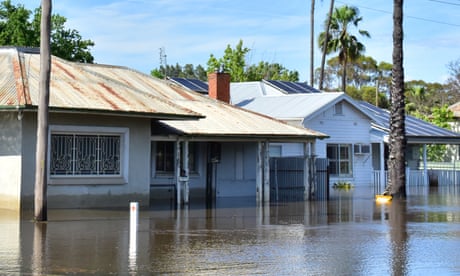- by foxnews
- 08 Apr 2025
Australia’s ‘unraveling’ climate risk leaving more homes uninsurable against flooding, expert warns
Australia’s ‘unraveling’ climate risk leaving more homes uninsurable against flooding, expert warns
- by theguardian
- 26 Nov 2022
- in news

When Kim Sly moved to a lower-lying area of Forbes four years ago, she was asked to pay $12,000 a year for flood insurance.
The bill was a shock. Her new home was built 1.2 metres above the ground to protect it from floods, a factor that did not seem to influence the insurance company's assessment.
By now, she would have paid a staggering $48,000 in insurance costs.
"It is a huge amount of money," she said. "I've always believed in insurance. I've never not been insured for anything, you know, houses, cars."
When the floods hit Forbes this month, the water inundated her yard and shed. She only lost incidentals. "We were one of the lucky ones," she says.
Just to the east, in flood-ravaged Eugowra, Greg Agustin had his mechanic workshop ruined during last week's disaster. Half the roof has collapsed and the timber supports broke and splintered from the force of the flood waters.
Agustin said he simply couldn't afford the exorbitant cost of flood insurance in Eugowra. His prospects of reopening are now dependant on how much support the state and federal governments offer.
"I'm insured for fire, but the flood insurance is impossible," he said.
"The cost of it. It's very hard to get flood insurance anyway. Up the road they quoted one lady $25,000, 10 years that's $250,000."
New data shows stories like Sly and Agustin's are becoming increasingly common. Rising costs associated with climate crisis hazards are making more and more homes uninsurable.
Data from Climate Valuation shows there are at least 17 Australian suburbs where more than half its properties will be uninsurable by 2030.
The chief executive of Climate Valuation, Karl Mallon, said the prediction that properties would become too expensive to insure due to global heating is unfolding faster than expected in the wake of this year's flood disasters in Australia's eastern states.
"We are now hearing about traditional insurance companies starting to withdraw cover. Where they're saying, well, we don't want to keep offering coverage in this particular town," Mallon said.
"We thought we had a bit of time but I think things are unraveling fairly quickly now."
Mallon predicted a severe price shift in insurance is on the cards not only for areas hit by the most recent flood disasters, but "frankly any flood zones" around Australia.
Climate Valuation classifies a property as high risk and will use the phrase "uninsurable" when the technical insurance premium exceeds 1% of the replacement value of a house.
Climate Valuation classified 10-20% of Eugowra's properties at high risk. However, 90% of its buildings sustained damage from flood waters last week.
Mallon said in the recent floods "some of the places that we're seeing flooded very severely are places that in our flood data would be considered at low risk."
Mallon said "in my view, these are failures of the property market. And when I say property market, I mean planning, development and construction, insurance and the financing sector.
"We're now seeing that the system is not able to cope with climate change."
As far as the insurance industry is concerned, Mallon said the sector needs to create mechanisms so that premiums take into account a property being built in a climate resilient way.
Doing so would send a signal to the market that homes built without consideration of climate will be hit with higher premiums or no coverage at all, but sensible insurance premiums can be offered for homes built with consideration to the risks posed by the heating climate , he said.
Often simple flood protections (such as raised Queenslander-style homes which allow flood waters to pass underneath) are no longer taken with modern buildings, according to Mallon.
Mallon said insurance providers like IAG (Insurance Australia Group) and Suncorp are attempting to send those signals, but are currently outliers.
An IAG spokesperson said that customers' premiums are assessed at their individual property level using the latest available data to review a property's risk of exposure to disasters such as flooding.
"For insurance to become more affordable for people in high-risk areas for extreme weather events, we need to reduce their level of risk by investment in mitigation initiatives.
"In addition to investment in mitigation, improved land-use planning and enhanced building codes must also be a key focus," the spokesperson said.
Mallon predicts 2023 will bring "quite a big insurance shock and I think we'll see a very rapid mortgage shock to follow."
He said as banks are coming under more pressure from regulators and shareholders to consider climate risks, they are trying to ensure the homes they are providing mortgages for have flood insurance.
"So the places where people are going to start to have trouble with insurance because either it's unavailable or unaffordable, are also starting to expect it to affect increasing problems getting a mortgage.
"It's going get harder to start to sell these properties because they're going to be harder to buy."
"I think the government does need to start to force companies in the insurance sector to recognise that they can't just have a one-size-fits-all [premium] if you're in a flood zone.
"Otherwise, what we'll end up with is more and more sections of Australia that just become uninsurable, which is not a an acceptable outcome for a developed country," Mallon said.
- by foxnews
- descember 09, 2016
Ancient settlement reveals remains of 1,800-year-old dog, baffling experts: 'Preserved quite well'
Archaeologists have recently unearthed the remarkably well-preserved remains of a dog from ancient Rome, shedding light on the widespread practice of ritual sacrifice in antiquity.
read more


